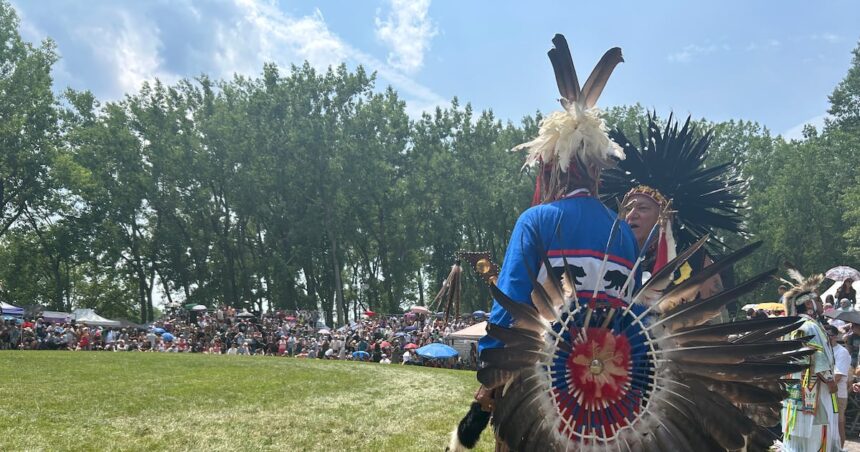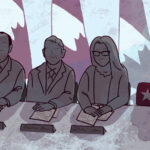As the sun dipped behind the trees at Kahnawake territory last weekend, the rhythmic beats of traditional drums echoed across the powwow grounds, marking a poignant milestone: 35 years since the Oka Crisis that forever changed Indigenous-settler relations in Quebec.
The annual Echoes of a Proud Nation Pow Wow took on special significance this year, drawing thousands of visitors from across Montreal and beyond to commemorate what many here call a turning point in modern Mohawk history.
“This isn’t just a celebration – it’s living memory,” explains Elder Joseph McComber, who participated in the 1990 standoff. “For 78 days, we stood our ground. Today, we gather not in anger but in strength, showing how our culture continues to thrive.”
The 1990 Oka Crisis began when the town of Oka planned to expand a golf course onto disputed land that included a Mohawk burial ground. The ensuing confrontation escalated into an armed standoff involving the Sûreté du Québec, the Canadian Armed Forces, and Mohawk Warriors from Kahnawake and Kanesatake.
Walking through the grounds, I’m struck by the vibrant display of resilience. Colorful regalia catches the afternoon light as dancers of all ages participate in traditional competitions. Vendors line the perimeter, offering everything from handcrafted jewelry to traditional medicines.
“The first powwow after the crisis was an act of healing,” says Alana Goodleaf-Rice, one of the event organizers. “Thirty-five years later, it continues to bring people together. The crisis was painful, but it awakened many Canadians to Indigenous realities that had been ignored for too long.”
Indeed, many attendees I spoke with believe the Oka Crisis marked a watershed moment in Canadian consciousness. Before social media could instantly broadcast global injustices, images of the standoff made international headlines.
Montreal resident Marie Tremblay brought her children to experience the cultural celebration. “I was too young to understand when it happened, but now I want my kids to learn this history firsthand,” she tells me while watching a youth dance competition. “These stories aren’t taught properly in our schools.”
What stands out at this anniversary gathering is the intergenerational dialogue happening at every turn. Elders who lived through the crisis share stories with teenagers who weren’t yet born in 1990.
Sixteen-year-old Karahkwenhawi Cross represents this new generation. “My grandparents were here during the blockades,” she says, adjusting her jingle dress before a performance. “They’ve taught me that powwow isn’t just dancing – it’s resistance. It’s saying: we’re still here, our culture survives.”
According to data from the Quebec Native Women’s Association, interest in Indigenous cultural events has grown steadily since the 1990s, with attendance at major powwows increasing by nearly 40% in the past decade alone.
The economic impact is significant too. A recent study by Tourism Montreal estimates that cultural tourism centered around Indigenous events brings approximately $8.5 million annually to the greater Montreal region.
Beyond statistics, there’s something profoundly moving about watching survivors of the crisis laugh with their grandchildren while sampling traditional foods or selecting handcrafted items.
“After the barricades came down, we needed healing,” reflects former Kahnawake Chief Joe Norton, who led the community during those turbulent months. “The powwow became our medicine. Today, it’s both commemoration and celebration.”
Not all wounds have healed, however. Many community members express frustration over ongoing land disputes and what they see as unfulfilled promises from various levels of government.
“The crisis brought attention, but true reconciliation requires action,” says Professor Audra Simpson from McGill University’s Indigenous Studies program. “Events like this powwow create space for cultural pride, but structural changes move much more slowly.”
As night falls, the grand entry begins. Dancers of all ages enter the circle behind eagle staff carriers and veterans. The announcer asks spectators to stand out of respect, and the crowd falls silent.
In this moment, the dual purpose of the gathering becomes clear – celebration intertwined with remembrance. For the Mohawk community, the powwow represents cultural continuity despite historical attempts at erasure.
“We invite everyone to share in our traditions today,” says Goodleaf-Rice. “But we also ask them to remember why this powwow exists – because people were willing to stand up for what was sacred.”
As I prepare to leave, a summer shower begins, but no one seems deterred. The drums continue, dancers adjust their regalia, and conversations carry on under hastily erected canopies.
The rain feels symbolic somehow – cleansing yet temporary, much like the media attention that briefly focused on Indigenous issues during the crisis before moving elsewhere.
But here in Kahnawake, the memory remains vibrant, passed down through stories, songs, and gatherings like this one – ensuring that what happened in those 78 days will never be forgotten.







